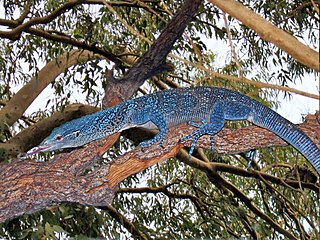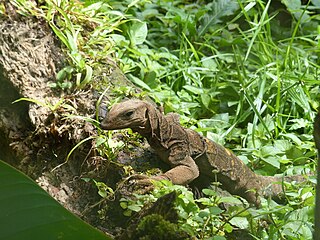
Monitor lizards are large lizards in the genus Varanus. They are native to Africa, Asia, and Oceania, and one species is also found in the Americas as an invasive species. About 80 species are recognized.

Varanus salvadorii, also known as the crocodile monitor, Papua(n) monitor, Salvadori's monitor, and artellia, is a species of monitor lizard endemic to New Guinea. It is the largest monitor lizard known from New Guinea, and is one of the longest lizards in the world, verified at up to 244 cm (8 ft). The tail of the species is exceptionally long, so some specimens have been claimed to exceed the length of the world's largest lizard, the Komodo dragon; however, V. salvadorii is far less massive.

The mangrove monitor, mangrove goanna, or Western Pacific monitor lizard is a member of the monitor lizard family with a large distribution from northern Australia and New Guinea to the Moluccas and Solomon Islands. Populations from the Marshall Islands, Caroline Islands, and Mariana Islands formerly classified in V. indicus are now considered to comprise two distinct species. It grows to lengths of 3.5 to 4 ft.

The emerald tree monitor or green tree monitor, is a small to medium-sized arboreal monitor lizard. It is known for its unusual coloration, which consists of shades from green to turquoise, topped with dark, transversedorsal banding. This coloration helps camouflage it in its arboreal habitat. Its color also makes the emerald tree monitor highly prized in both the pet trade and zoos alike.

Mertens' water monitor, also called commonly Mertens's water monitor, and often misspelled Mertin's water monitor, is a species of lizard in the family Varanidae. The species is endemic to northern Australia, and is a wide-ranging, actively foraging, opportunistic predator of aquatic and riparian habitats. It is named after German herpetologist Robert Mertens.

The peach-throated monitor, also known commonly as the Sepik monitor, is a species of monitor lizard in the family Varanidae. The species is native to New Guinea.

The Northern Sierra Madre forest monitor, also known by the local names bitatawa, baritatawa, and butikaw, is a large, arboreal, frugivorous lizard of the genus Varanus. The lizard is a distinctive food of the Aeta and Ilongot indigenous people of the Philippines.

The blue-tailed monitor, blue-tailed tree monitor or Kalabeck's monitor, is a monitor lizard of the Varanidae family. It belongs to the V. doreanus group of the subgenus Euprepiosaurus.
The sago monitor or torch monitor, Varanus obor, is a species of monitor lizards endemic to the Indonesian island of Sanana.
Finsch's monitor is a species of monitor lizard in the family Varanidae. The species is found in New Guinea and Australia.
The Rennell Island monitor is a species of monitor lizards found in the Solomon Islands archipelago. It is also known as the Hakoi Monitor. It belongs to the subgenus Euprepiosaurus along with the canopy goanna, the peach-throated monitor, Kalabeck's monitor, and others.

The quince monitor is a species of monitor lizards endemic to Indonesia. It is very closely related to the mangrove monitor, with both belonging to the subgenus Euprepiosaurus.

Varanus macraei, the blue-spotted tree monitor or blue tree monitor, is a species of monitor lizard found on the island of Batanta in Indonesia. It is named after herpetologist Duncan R. MacRae, founder of the reptile park Rimba on Bali.
Varanus zugorum, also known commonly as the silver monitor or Zugs' monitor, is a species of monitor lizard in the family Varanidae. The species is endemic to the island of Halmahera in the Moluccas, in Indonesia.
Varanus telenesetes, the mysterious tree monitor, is an enigmatic monitor lizard that may actually represent a colour faded specimen of the green tree monitor. The species was described based on a single specimen supposedly collected on Rossel Island in the Louisiade Archipelago of Papua New Guinea. However, later searches of this island have failed to turn up any specimens and native islanders deny ever seeing it. It is now believed that the original collection data was in error and that the species occurs on some other, currently unknown, island east of New Guinea.
Varanus rainerguentheri, commonly known as Rainer Günther's monitor, is a species of lizard in the family Varanidae. The species is endemic to the Moluccas.

Varanus spinulosus, the Solomon Island spiny monitor, Isabel monitor, or spiny-neck monitor, is a species of monitor lizard. It is endemic to the Solomon Islands archipelago and is also known from Santa Isabel Island, San Jorge Island and Bourgainville Island.
The tricolor monitor, also commonly known as the black-backed mangrove monitor or the black-backed monitor, is a species of monitor lizard in the blue-tailed monitor species complex. The tricolor monitor is endemic to the island of Halmahera, in the Maluku Islands, Indonesia.

The subgenus Odatria, sometimes known as the dwarf monitor lizards, consists of small monitor lizards found in Australia and Indonesia. Species in this subgenus include the smallest monitor species in the world, the tiny 16 gram Dampier Peninsula monitor, but also includes some more medium sized species such as the 240 gram black-palmed rock monitor.

The subgenus Hapturosaurus, sometimes known as the tree monitors, consists of slender-bodied arboreal monitor lizards mostly found in the tropical rainforests of Indonesia and Papua New Guinea.














